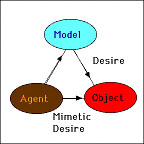
(pic borrowed from: http://www.cs.utk.edu/~evers/think/mimesis/theory.htm)
‘Representation’ is not only a key concept in biomedicine, but also in museology and in the history of medicine. In all three realms the concept of ‘representation’ bridges the gulf between ‘pure’ science and ‘pure’ art. Scientific reports, historical narratives and exhibitions — all three transcend the neat dichotomy between culture as a mirror (of society or nature) and culture as construction (of society or nature). This conference could be an opportunity to develop further the notion of medical museology as a ‘boundary discipline ‘ between visual art, historiography and science:
Beyond Mimesis and Nominalism: Representation in Art and Science
Two-day conference in London, 22-23 June 2006
Representations play a critical role in both science and art. Perceived as different in kind, artistic and scientific representations have been studied as objects of distinct disciplinary and intellectual traditions. However, recent work in both the philosophy of science and studies of the visual arts suggests that these apparently different representational traditions may be related in challenging and provocative ways. “Beyond Mimesis and Nominalism,” a conference co-sponsored by the Courtauld Institute of Art Research Forum, the London School of Economics, and the Institute of Philosophy of the University of London, seeks to open conversations between and beyond these compartmentalized traditions of thinking about representation.
According to dominant accounts, scientific representation is explained by appeal to mimetic relationships such as similarity or formal relations like isomorphism. As these views have been subjected to increasing criticisms, recent approaches to scientific representation have begun to draw upon analogies with artistic representation. Significantly, parts of this emergent literature have turned to a “nominalist” position, not unlike that advocated by Nelson Goodman in his writings on representation in art.
But, a similar turn is already apparent within studies of visual art, where scientific representations are increasingly integrated into the analysis of art. Like their colleagues in the philosophy of science, recent scholars in the visual arts have seen Goodman’s work as an important point of engagement. His pioneering work on the visual has informed recent efforts to expand semantic taxonomies and to analyze the increasing field of images that fall outside classification as “art.” As this work has received important contribution from scholars concerned with scientific imaging, the project of rethinking representation is one of growing general importance to art-historical studies, whose interpretative scope has expanded dramatically outward in recent decades.
In order to press this emergent interdisciplinary conversation, scholars from all disciplines are invited to submit papers to this two-day international conference. We particularly seek submissions that explore the “how” of representation — papers that can enrich our understanding of the techniques employed in scientific representation and/or address their semantic structures or historical convergences with artistic practices — and vice versa. Also especially encouraged are papers that critique, historicize or defend the conference’s central terms of mimesis and nominalism, or offer approaches to representations that navigate a middle course between them.
Please send extended abstracts of up to 1000 words to ph-artandscience@lse.ac.uk by 1 March 2006. Decisions will be made by 1 April.
Keynote speakers: Catherine Elgin (Harvard University) and James Elkins (School of the Art Institute of Chicago/University College Cork, Ireland); Organisers: Roman Frigg (LSE) and Matthew Hunter (Courtauld Institute of Art/University of Chicago); Programme committee: Peter Ainsworth (LSE), Roman Frigg (LSE), Matthew Hunter (Courtauld Institute of Art/University of Chicago), Elisabeth Schellekens (King’s College London), Christine Stevenson (Courtauld Institute of Art), and Sabine Wieber (Birkbeck College London)
Springer Publishers has shown interest, and by agreement with individual authors, the conference organizers will be submitting edited versions of selected papers for possible publication in Springer’s philosophy programme.
Konference “Representation in Art and Science”, London 22 – 23 June
(pic borrowed from: http://www.cs.utk.edu/~evers/think/mimesis/theory.htm) ‘Representation’ is not only a key concept in biomedicine, but also in museology and in the history of medicine. In all three realms the concept of ‘representation’ bridges the gulf between ‘pure’ science and ‘pure’ art. Scientific reports, historical narratives and exhibitions — all three transcend the neat dichotomy between culture […]


